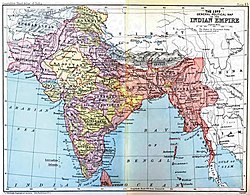Muslims in India
| Total population | |
|---|---|
| approx. 189 million (2017 estimate) | |
| Regions with significant populations | |
|
Throughout India Majority in Jammu and Kashmir and Lakshadweep. Large concentration in Assam and West Bengal. Large populations in Uttar Pradesh, Bihar, Maharashtra and Kerala. |
|
| Languages | |
| Main languages spoken are Hindi languages, Urdu, Bengali, Dakhini, Kashmiri, and some other regional languages of India | |
| Religion | |
| Sunni, Ahle Sunnat Barelvi, Ahmadiyya, Shia, Bohra, Nizari, Wahabi and Deobandi. |

Imperial entities of India
|
|
| Dutch India | 1605–1825 |
|---|---|
| Danish India | 1620–1869 |
| French India | 1668–1954 |
|
|
|
| Casa da Índia | 1434–1833 |
| Portuguese East India Company | 1628–1633 |
|
|
|
| East India Company | 1612–1757 |
| Company rule in India | 1757–1858 |
| British Raj | 1858–1947 |
| British rule in Burma | 1824–1948 |
| Princely states | 1721–1949 |
| Partition of India |
1947
|
|
|
|
Islam is the second largest religion in India, with 14.2% of the country's population or roughly 172 million people identifying as adherents of Islam (2011 census). Islam first came to the western coast of India when Arab traders as early as the 7th century CE came to coastal Malabar and Konkan-Gujarat.Cheraman Juma Mosque in Kerala is thought to be the first mosque in India, built in 629 CE by Malik Deenar.Following an expedition by the governor of Bahrain to Bharuch in the 7th century CE, immigrant Arab and Persian trading communities from South Arabia and the Persian Gulf began settling in coastal Gujarat.Ismaili Shia Islam was introduced to Gujarat in the second half of the 11th century, when Fatimid Imam Al-Mustansir Billah sent missionaries to Gujarat in 467 AH/1073 CE. Islam arrived in North India in the 12th century via the Turkic invasions and has since become a part of India's religious and cultural heritage. Over the centuries, there has been significant integration of Hindu and Muslim cultures across India and Muslims have played a prominent role in India's economic rise and cultural influence.
Trade relations have existed between Arabia and the Indian subcontinent since ancient times. Even in the pre-Islamic era, Arab traders used to visit the Konkan-Gujarat coast and Malabar region, which linked them with the ports of Southeast Asia. Newly Islamised Arabs were Islam's first contact with India. Historians Elliot and Dowson say in their book The History of India, as Told by Its Own Historians, that the first ship bearing Muslim travellers was seen on the Indian coast as early as 630 CE. H.G. Rawlinson in his book Ancient and Medieval History of India claims that the first Arab Muslims settled on the Indian coast in the last part of the 7th century CE. (Zainuddin Makhdoom II "Tuhafat Ul Mujahideen" is also a reliable work.) This fact is corroborated by J. Sturrock in his Madras District Manuals and by Haridas Bhattacharya in Cultural Heritage of India Vol. IV. It was with the advent of Islam that the Arabs became a prominent cultural force in the world. Arab merchants and traders became the carriers of the new religion and they propagated it wherever they went.
...
Wikipedia
